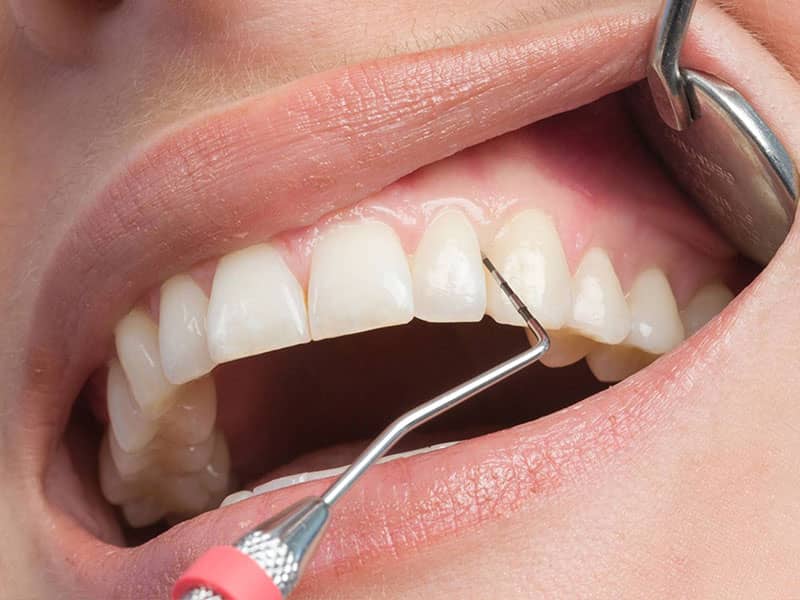
Periodontology is the branch of dentistry that deals with pathologies affecting the supporting tissues of the tooth (gingiva and alveolar bone). The pathologies that periodontology treats are typically gingivitis and periodontitis.
Gingivitis is a reversible problem that can occur in the gums. However, if this problem is neglected, it can turn into periodontitis. Periodontitis, also known as pyorrhea or periodontal disease, is an inflammatory disease that affects the deepest periodontal tissues (cementum root, periodontal ligament, and alveolar bone). Symptoms that can act as alarm bells include:
- Bleeding gums,
- Pain during daily cleaning of teeth,
- Bad breath.
If not diagnosed and treated in time, periodontitis can cause tooth loss.
Periodontal diseases are mainly caused by other identified risk factors such as poor oral hygiene, smoking, diabetes, and family predisposition. The accumulation of bacteria in the form of bacterial plaque between the teeth and gums can turn into tartar if not cleaned properly. These cause tooth loss by causing periodontal pocket formation, tooth mobility, and destruction of periodontal tissues.
Causes of Periodontal Disease
Those who do not pay attention to good oral hygiene and have an individual predisposition to the disease can get periodontal disease. In particular, the causes and supporting factors of periodontal disease are:
- Inadequate Oral Hygiene: It is the main cause of periodontitis cases. Bacterial plaque first causes gingivitis and then turns into periodontitis.
- Smoking: Smokers have a higher risk of developing periodontitis than non-smokers. This disease usually progresses more rapidly in smokers, has a more aggressive course, and is less responsive to treatment.
- Genetic Predisposition: Some people suffer from the periodontal disease despite impeccable oral hygiene, while others may have healthy periodontal structures despite masses of tartar and plaque. Approximately 27% of the population inherits a gene predisposes them to periodontal disease.
- Stress: Many scientific studies have highlighted the relationship between stress and periodontal disease, possibly because stress weakens the immune system.
- Pregnancy: Strong hormonal fluctuations facilitate the onset of gingivitis and periodontitis.
- Certain Diseases: Mainly diabetes and certain forms of rheumatoid arthritis and congenital or acquired immunodeficiencies (AIDS, etc.) can trigger this problem.
Periodontology Treatment
Depending on the stage and degree of periodontal diseases, anti-infective therapy, antibiotic therapy, or surgical intervention may be required. Progress of treatment is monitored as part of the evaluation of the findings. Supportive treatment can be applied at regular intervals to ensure results. Teeth cleaning is an important part of treatment. In general, the treatment of periodontal diseases such as periodontitis consists of the following steps:
- History, Findings, Diagnosis and Documentation: Prerequisite for treatment is disease-specific anamnesis, clinical findings, and diagnosis. Depending on the diagnosis, dentists decide whether it needs treatment.
- Periodontological Information (Consultation): Patients receive information about the findings and diagnosis during the consultation. In addition, dentists discuss the relevant treatment steps and, if necessary, alternatives. Part of the discussion also explains the importance of health-conscious behaviour for reducing risk factors such as smoking. In addition, patients are informed about interactions with other diseases.
- Conservative Measures: Depending on the indication, dental protection measures are carried out before or during periodontology treatment.
- Patient-specific Oral Hygiene Instruction: The patient is given specific oral hygiene instructions in connection with anti-infective therapy. On the other hand, the state of inflammation of the gums is determined. Finally, the dentist informs patients about proper individual oral hygiene and shows them possible aids or practices.
- Anti-infective Therapy: Anti-infective therapy is a closed procedure in which all accessible soft or hard deposits, biofilms, and calculus (tartar under the gums) are removed from the periodontal pockets.
- Antibiotic Therapy: In particularly severe forms, the doctor may prescribe systemic antibiotics simultaneously as anti-infective therapy.
- Evaluation of The Findings: A few months after the end of anti-infective therapy, the first assessment of periodontal signs are made. The next procedure can be fully planned by comparing the findings with the data, and other periodontal problems that require treatment can be determined. Surgical treatment can be applied if necessary, including a re-evaluation of the findings. Otherwise, supportive treatment follows directly.
- Surgical Treatment: In some cases, surgical intervention in periodontal pockets may be necessary. Whether or not such a procedure should be performed, the dentist consults with the patient and makes a joint decision.
How to Prevent Periodontal Diseases?
The two most important ways to prevent periodontal diseases such as gingivitis or periodontitis are:
- Brushing teeth at least twice a day with a soft-bristled toothbrush or electric toothbrush,
- Make regular visits (at least twice a year) to the dentist.
Some Important Tips
It is very important to maintain good oral hygiene and regularly consult a dentist to prevent dental problems. However, it is necessary to take precautions for dental health from an early age. According to a recent study, gingivitis chronically affects 24% of 18- to 30-year-olds and 27% of 60- to 77-year-olds. This shows that good dental hygiene is essential for all ages.
Brushing the teeth should be done using a small-sized soft toothbrush that is changed frequently and fluoride toothpaste. These provide additional protection to the teeth. It is also important to use dental floss to reach narrow spaces between teeth.
However, chewing causes more saliva to be produced, which helps to destroy the acids produced by bacteria. Thus, sugar-free gum can be chewed after each meal. In addition, it is necessary to pay attention to the diet to limit the production of this toxin by the bacteria.
Sugar is the favourite substance of microorganisms in the mouth. These are responsible for the demineralization of teeth by metabolizing them and thus the appearance of cavities, among other issues. Therefore, sugary foods should be reduced.
